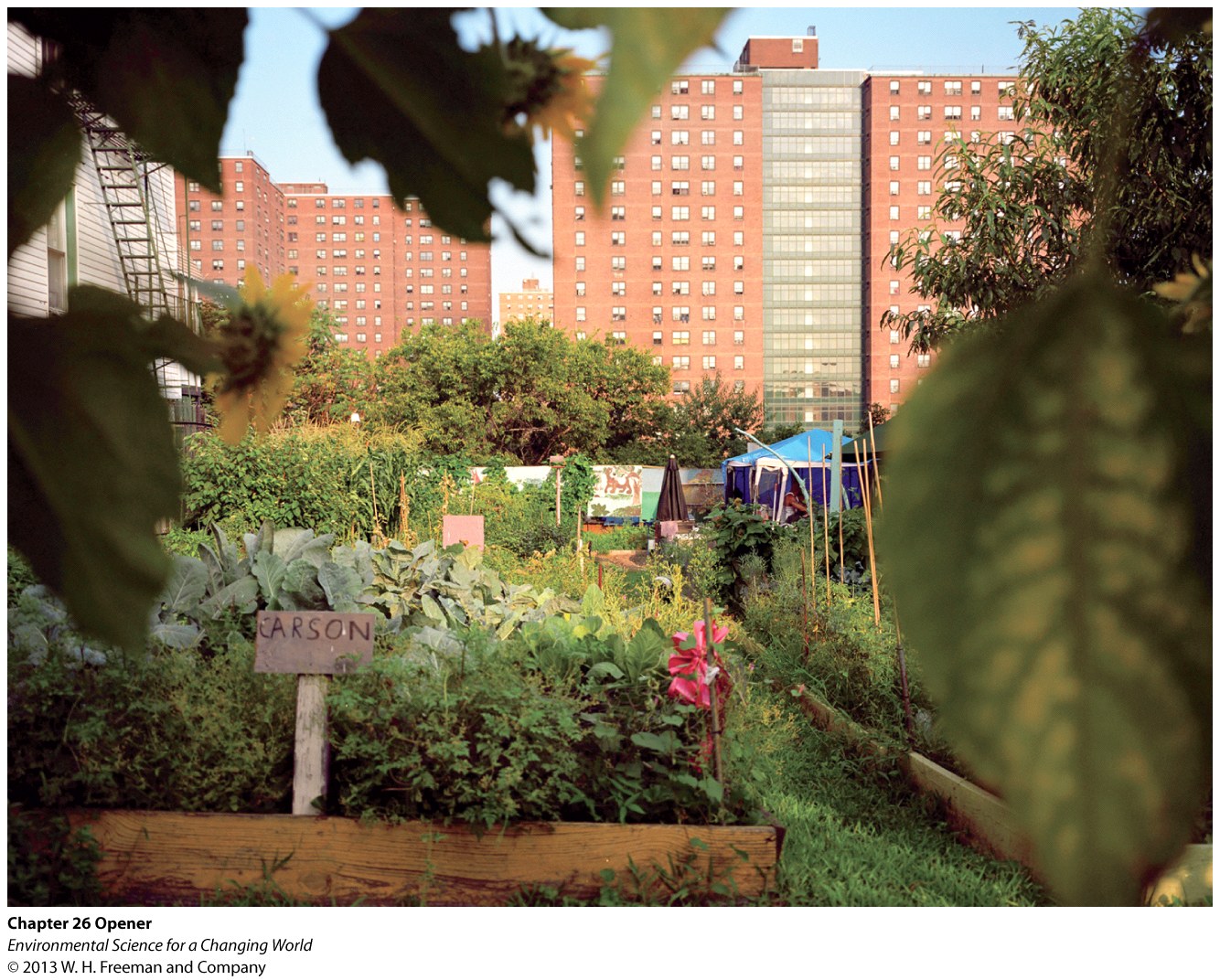
Chapter 26. Chapter 26: Urbanization and Sustainable Communities
What are the trade-offs associated with cities...?

Guiding Question 26.2
What are the trade-offs associated with cities or urban areas?
Why You Should Care
Chances are, if you haven’t been already, you’ll be faced with deciding where to live and start a career. You also probably have a good grasp of the pros and cons of city life. If you lived in the city, you’d probably be closer to work and a more diverse array of entertainment, people, and food. But you’d have to pay more to live there; in fact, you probably couldn’t afford to buy a home. It’s also crowded and could be noisy or polluted. If you lived in the suburbs, you’d have room to move around, but you’d have to do a lot more driving—to get to work, buy food, etc. Many of the environmental pros and cons are readily apparent, too. Living in cities saves land resources and should reduce carbon footprints since you don’t need to drive as much. But large amounts of waste are produced by cities, and disposing of it causes both environmental and social problems. Moreover, cities tend to be hotter than the surrounding countryside. Even the difference of a few degrees can make a huge difference in the environment—even if the hotter weather in cities is only enough to make air conditioners run a few extra minutes each day. Multiply that by millions of homes in a city and it’s a huge problem, especially if the electricity provided for the city is derived from coal. Although city and suburban living both have their drawbacks, the prospects of making city living sustainable are better than the suburbs, so hopefully, the current trends to make cities greener will continue.

1.
Thought Question: The y axis specifically lists the units as CO2-equivalent greenhouse gas emissions. What do you think this means?
Incidentally, if you were to measure just CO2 produced for energy and construction (making concrete releases CO2) but not CO2 and other gases emitted from other sources, like land clearing, China comes out slightly ahead of the United States.
2.
Refer to Infographic 26.2 above. Of the country-city pairs, the one with the largest disparity between average and city carbon footprint is:
| A. |
| B. |
| C. |
| D. |
3.
Homes in urban areas tend to be _______ compared to rural areas.
| A. |
| B. |
| C. |
| D. |
4.
The numbers listed in the circles on the graph refer to:
| A. |
| B. |
| C. |
| D. |
5.
If you were to turn the numbers into a story, you could sum it up best by saying that the graph in Infographic 26.2 is portraying:
| A. |
| B. |
| C. |
| D. |
6.
The graph in Infographic 26.2 is showing the per capita carbon footprint for the different countries and cities listed. How could you determine what the total carbon footprint is for all the countries combined?
| A. |
| B. |
| C. |
| D. |
7.
| Nation | Approximate Population in 2012* |
Carbon Footprint in Tons of Carbon per Year |
|---|---|---|
| Spain | 47,000,000 | |
| United Kingdom | 63,000,000 | |
| United States | 314,000,000 | |
| Brazil | 206,000,000_206000000 | |
| Japan | 127,000,000 | |
| China | 1,343,000,000 |
*As found in the United States CIA World Factbook; rounded to the nearest million people.
8.
Of the following countries, _____ has the highest annual carbon emissions.
| A. |
| B. |
| C. |
| D. |
9.
Of the following countries, ______ has the lowest annual carbon emissions.
| A. |
| B. |
| C. |
| D. |
10.
Thought Question: Using the U.S. figures as an example, would you expect the per capita emissions for people living in exurbs and suburbs to be higher or lower than the national average?
11.
All of the following are disadvantages to living in cities EXCEPT:
| A. |
| B. |
| C. |
| D. |
12.
_________ is NOT an advantage of living in cities.
| A. |
| B. |
| C. |
| D. |
13.
The urban heat island effect is caused by all of the following EXCEPT:
| A. |
| B. |
| C. |
| D. |
14.
_________ do/does NOT contribute to the lower per capita footprint found in most cities.
| A. |
| B. |
| C. |
| D. |
15.
Relative to suburbs and rural areas, cities have:
traffic congestion.
green space.
environmentally caused illness.
concentration of waste to be disposed of.
violence.
transportation options.
ecological impact per person.
effective zoning ordinances (usually).
average temperature.
dependence on food and resources that aren't local.
advanced health-care options.
diversity of job opportunities.
home energy efficiency.
traveling to get to work and to buy goods or services.
difficulty handling stormwater runoff and flooding.
air quality.
homes on average.
educational opportunities.
Activity results are being submitted...